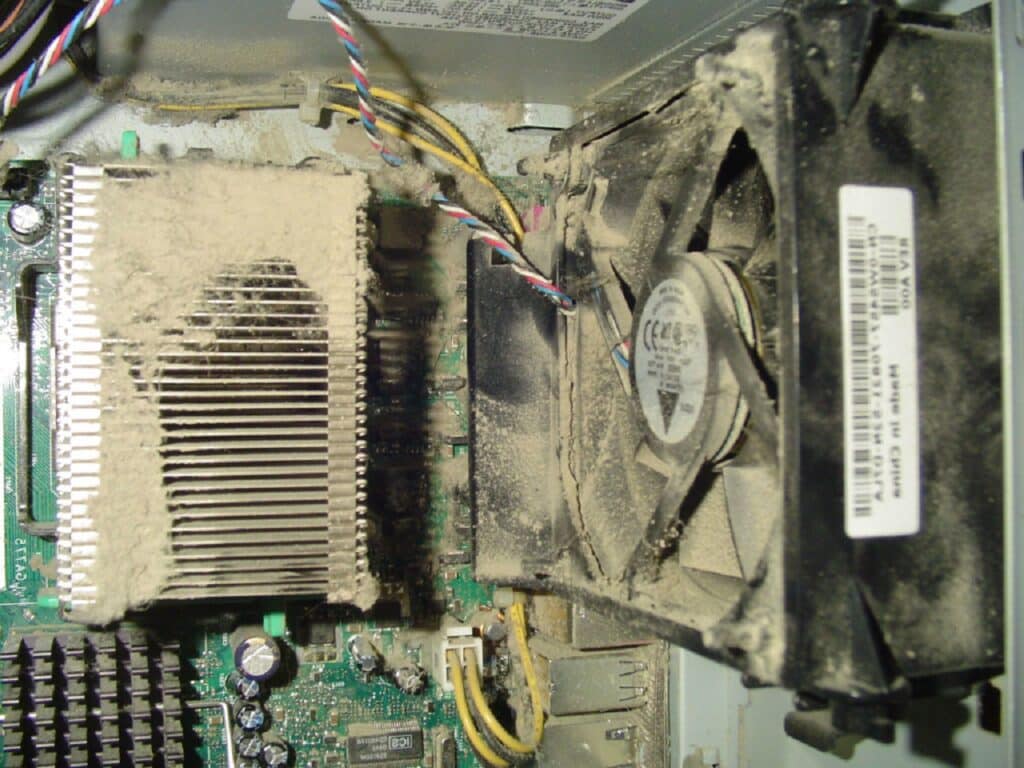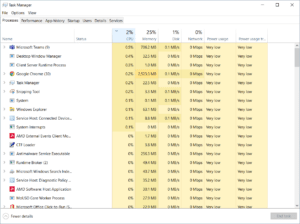Klientidelt, eriti suvekuudel, tuleb sageli küsimus, et nende miniarvuti on liiga kuum. Selles artiklis selgitame, miks miniarvutid võivad soojeneda ja millistel temperatuuridel neid saab kasutada. Uurime, kuidas teada saada, kas arvuti on tegelikult liiga kuum, ja kuidas aidata oma miniarvutit jahedana hoida.
Mis võib mu miniarvuti liiga kuumaks teha?
Teie miniarvutis tekitavad soojust mõned komponendid, tavaliselt protsessor, GPU ja salvestusruum. Nende komponentide kaudu kulgev elekter toodab soojust, mis võib aja jooksul kuhjuda, kui seda ei hallata õigesti.
Tekkinud soojuse hulk võib sõltuda komponentide energiavajadusest. Näiteks energiatõhusa miniarvuti, mille protsessor on Intel Celeron N5105, nagu näiteks miniarvuti GMKTEC Nucbox5, soojuskoormus (TDP) on kõigest 10 W. Traditsiooniline lauaarvuti Intel i7-12700K-ga võib olla kuni 190W! Mida rohkem energiat protsessorist läbi käib, seda rohkem soojust tekib.
Kõigi arvutite puhul, kus tekib soojust, on olemas võimalused süsteemi jahutamiseks. Komponentide külge kinnitatakse jahutusradiaatorid, et hajutada soojus protsessorist eemale. Need on tavaliselt valmistatud alumiiniumist või vasest, mis on head soojusjuhid.
Sõltuvalt konstruktsioonist võib olla jahutusventilaator, mis kas surub õhku komponentidele või surub kuuma õhku korpusest välja. Sõltuvalt suurusest võib teil olla kaks ventilaatorit, üks värske õhu sissetoomiseks ja teine selle väljutamiseks.
Kui tunnete, et teie miniarvutist tuleb kuuma õhku, siis on see hea ja ei ole põhjust muretseda. See tähendab, et jahutusradiaator ja ventilaator teevad oma tööd ja tõmbavad kuuma õhu välja.
Miks on minu miniarvuti kuum?
Kõik arvutid võivad kuumeneda, võivad olla välised tegurid, mis mõjutavad temperatuuri. Näiteks kui keskkond on soojem kui keskmine toatemperatuur 21 °C. Kui toatemperatuur on soojem, siis mõjutab see loomulikult miniarvuti sisetemperatuuri. Suvekuudel on temperatuurid soojemad, mis toob kaasa soojema keskkonna ja soojemad miniarvutid.
Ka miniarvuti asukoht võib mõjutada temperatuuri. Soovitame hoida miniarvutit vabas kohas, mitte suletud ruumis, näiteks telerikapis. See võib põhjustada soojuse kuhjumist suletud ruumis, kust soojus ei saa kuhugi kaduda. Kõikidel külgedel peaks olema paar sentimeetrit avatud ruumi, et jahe ja soe õhk saaks hajuda.
Üks levinumaid põhjuseid on tolmu kogunemine ventilaatorite võrede, väljalaskeavade ja miniarvuti sisemusse. Tolm võib blokeerida külma õhu sissevoolu ja sooja õhu väljapääsu. Samuti võib see koguneda komponentidele, tekitades "teki", mille kaudu soojus ei haju enam tõhusalt.
Mis on miniarvuti jaoks liiga kuum?
Maksimaalsed temperatuurid, mille juures protsessorid võivad töötada, on mudelite ja nende protsessorite puhul erinevad. Kuid üldiselt võib miniarvuti protsessor töötada üle 100 °C. Vaatleme mõnda erinevat mini-PC mudelit ja nende maksimaalset töötemperatuuri (Tjmax / Tjunction):
GMKTEC NucBox5 ventilaatorita miniarvuti Intel® Celeron® protsessoriga N5105 - 105°C
DroiX Proteus 11 Intel Core i5-1135G7 protsessoriga - 100°C
Beelink GTi10 Intel Core i3-1005G1 protsessoriga - 100°C
Minisforum HX90 miniarvuti AMD Ryzen 9 5900HX protsessoriga - 105°C
Kuigi me ei soovita oma miniarvutit pidevalt kõrgel temperatuuril käitada, on see lühiajaliselt täiesti okei. Tavalises keskmise temperatuuriga keskkonnas ei tohiks teie miniarvuti töötada üle 75 °C. Kuid pidage meeles, et näiteks suvekuudel võib see temperatuur tõusta kuni 90 °C-ni. See on tingitud sellest, et ümbritseva ruumi temperatuur on kõrgem.
Kõrgemad temperatuurid on ajutiselt ohutud, kuid aastaid kestev pidev kõrgemate temperatuuride hoidmine võib halvendada jõudlust või kahjustada komponente. Näiteks kui teie auto oleks pidevalt ülekuumenenud, hakkaks see lagunema ja lõpuks lakkaks töötamast. Kui see on nii, siis peate uurima, kuidas miniarvutit jahedana hoida.
Kuidas ma tean, kas mu miniarvuti on liiga kuum?
On mõned viisid, kuidas saate kindlaks teha, kas teie arvuti on liiga kuum. Kõige lihtsam viis on paigaldada temperatuuri jälgimise tarkvara, selle töö tegemiseks on saadaval palju rakendusi. Näiteks mina olen oma mini-PC-s kasutanud üle kümne aasta CoreTemp’i. See sobib suurepäraselt silma peal hoidmiseks, kui temperatuur jookseb liiga kõrgele.
Te võite märgata, et teie miniarvuti jõudlus on tavalisest aeglasem. See on tingitud sellest, et paljudel komponentidel on sisemine termomeeter. Kui komponentide temperatuur on liiga kõrge, siis vähendab see tekkiva soojuse vähendamiseks voolutarbimist. See tähendab, et jõudlus on tavapärasest väiksem. Mõelge sellele nagu sellele, kui võtate autos gaasi gaasipedaalilt maha, et vähendada mootorile antavat võimsust, et seda jahutada. See vähendaks siis teie sõidukiirust.
Mida ma saan teha, et mu miniarvuti jahedana püsiks?
Hoidke ala jahedamana
Me mainisime varem selles artiklis, et kui võimalik, kasutage oma miniarvutit avatud ruumis, kus on mõni tolli vahe seintest jne. See aitab väga palju kaasa sellele, et teie miniarvuti saaks jahedat õhku sisse võtta ja sooja õhku tõhusalt välja lasta.
Kasutage miniarvutit võimaluse korral jahedamas keskkonnas. Kui teil on konditsioneer, siis tõenäoliselt ei teki probleeme, sest ümbritseva ruumi temperatuur on madalam. Kuid paljudes riikides, näiteks Ühendkuningriigis, ei ole kliimaseadmed kodumajapidamistes tavalised. Nii lihtne asi nagu võnkuv ventilaator aitab tuua ruumi jahedat õhku.
Miniarvuti paigaldamine monitori tagaküljele võib samuti põhjustada täiendavat soojuse teket. Monitori tagakülg võib soojust välja paisata, mis väiksema õhuvoolu tõttu hoiab monitori taga asuvat ruumi soojemana. Kui teil on tunne, et ala on soojem, siis võite proovida jätta miniarvuti lauale.
Lülitage see välja, kui seda ei kasutata
Kui te lülitate oma miniarvuti välja, kui seda ei kasutata, peatate miniarvuti soojuse tekkimise. See võimaldab tal loomulikult jahtuda. Lisaks sellele vähendate ka energiakasutust, mille tulemuseks on odavamad elektriarved.
Kõrge protsessorikasutus
Kontrollige, millised rakendused on käimas. Kui teil on avatud või taustal töötab palju ebavajalikke rakendusi, võib see põhjustada pidevat suurt protsessorikasutust, mille tulemuseks on suurem soojus. Sa võid kontrollida, avades Windows Task Manager’i, millised rakendused kasutavad palju protsessorit ja sulgeda kõik mittevajalikud rakendused.
Ärge avage juhtumit "hingamiseks".
Sageli kuuleme, et korpuse avamine aitab seadet jahedamalt hoida. Tegelikult võib sellel olla vastupidine mõju, sest korpuse sisemine õhuvool on häiritud. See võib põhjustada ka seda, et korpusesse satub rohkem tolmu ja see koguneb. Me ei soovita korpust lahti jätta!
Tolm, keegi?
Kõik, mille sees on ventilaator, imeb tavaliselt tolmuosakesi üles. Need võivad ummistuda ventilaatori võrega või väljalaskeava või miniarvuti enda sees. Tolmu kogunemist aitab vältida kord nädalas toimuv kiire pühkimine ventilaatorivõre ja väljalaskepiirkonna üle.
Kuigi me ei soovita oma miniarvutit avada, kuna see võib muuta garantii kehtetuks. Paljusid saab 2,5-tollise kõvaketta/SSD paigaldamiseks ohutult avada. Kui ventilaatori ala on avatud, siis võite kasutada suruõhukannu või elektrilist tolmupuhastit, mis puhub tolmu ära.
Kokkuvõte
Oluline on meeles pidada, et enamikul juhtudel ei tööta teie miniarvuti liiga kuumalt. Väljalaskeava(te)st väljuv kuum õhk on hea, sest see tähendab, et kuum õhk eemaldatakse seestpoolt. Hoidke oma miniarvutit ventileeritavas ruumis, mille ümber on veidi ruumi, et see saaks sisse võtta jahedat õhku ja väljutada kuuma õhku. Lühike korrapärane hooldus, mustuse pühkimine kõikidest sisselaskeavadest või väljalaskeavadest aitab õhuvoolule miniarvuti sees kaasa.
Kõik miniarvutid DroiXis testitakse põhjalikult, enne kui me otsustame neid müüa. Me kontrollime, et nad töötavad spetsifikatsioonide, sealhulgas temperatuuride ja müratasemete piires.














